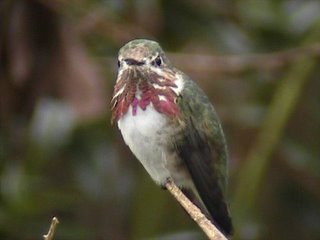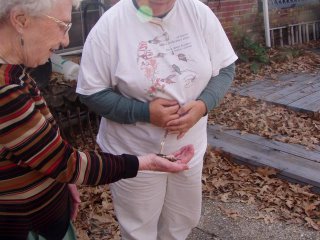How well can a Blue Jay *really* imitate a Red-Shouldered Hawk? Caught these two on video today. Thought the Hawk was flirting with another hawk til the Jay showed up!!
Sunday, December 31, 2006
Ever heard a Blue Jay imitate a Red-Shouldered Hawk?
10 feet tall and bullet proof!
Had a visitor to the yard today….a beautiful Cooper’s hawk! Needless to say, every bird in sight disappeared instantly…except for the juvie male Rufous hummer who guards the end of my driveway. He was divebombing the hawk if it moved, and cussing at it incessantly for as long as it was there. Fortunately it had its eyes on other things (house sparrows) and couldn’t be bothered with this tiny feisty morsel!
The dive-bombing in this video doesn’t show…but you can hear him cussing in the background (turn up the sound, but cover any tender ears in the room—such language, tsk tsk!!) http://dgpatterson.com/janebirds/CoopVsRufous.wmv
And here’s a closeup of the tough guy. Does he look 10 feet tall and bullet proof to you??? http://dgpatterson.com/janebirds/rusty_hum_side_good.wmv
Friday, December 29, 2006
They do eat bugs, they do, they do, they do!
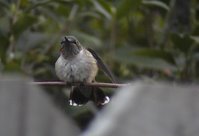
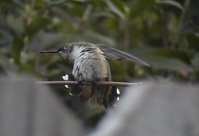
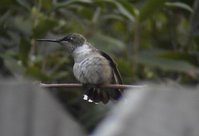
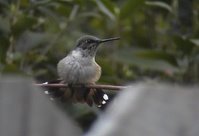
There were some postings recently on humnet (listserv for humnuts) regarding whether or not hummers are flycatchers to any significant degree. I don't think there's really a debate...I believe it's been ruled by examining stomach contents that they are, but it's rare to actually witness them at it. I was watching this little hummer today -- he's an overwintering juvenile male Ruby-Throat --and I caught him in action! You can even see the insect he's after! Some times it pays to be patient :-)
The short version of the video: http://dgpatterson.com/janebirds/Hum_Flycatching_short.wmv
The longer version of the video: http://dgpatterson.com/janebirds/Hum_flycatching.wmv
And a neat short clip of a great stretch and tail flare… http://dgpatterson.com/janebirds/R2_tail_flare.wmv
Sunday, December 17, 2006
Sorting out winter hummers...
 I'm trying to sort out the hummers that have visited me so far this winter, or at least the ones I've managed to photograph. There appear to be six distinct birds:
I'm trying to sort out the hummers that have visited me so far this winter, or at least the ones I've managed to photograph. There appear to be six distinct birds:#1 - The first winter bird was an adult female Sel R/A with a distinct triangular gorget and a lovely bracelet on her left leg. Since
#2 - I have another Sel R/A that has a
#3 – I am pretty sure this is a third Sel R/A. The coloring and the gorget looks different to me than my #1 bird. Also see no evidence of band. http://dgpatterson.com/janebirds/3rdRuf_close.wmv
#4 – I observed #4 and #5 on the same day. Or rather…I knew I had a bird that was not a Sel R/A but I hadn’t sorted it out yet. When I did manage to get a picture, two birds showed up! I call #4 “Fatty” because it’s, well, fat. J It also has a single reflective gorget feather to the lower right so I’ve been able to ID it by that (not definitive, I know, but raises probability with so few birds around). I think it might be a Ruby-throat, although it’s the mildest-mannered one I’ve seen. Twice I’ve seen it allow other birds on “his” feeder. His feather’s get ruffled but he rarely rants or take action. Very laid back bird, for a hummer. http://dgpatterson.com/janebirds/driveway_hum2.wmv
#5 – First observed this bird when it visited the feeder that #4 was guarding! He has a distinct 5-oclock shadow, but no reflective feathers in it that I can see. http://dgpatterson.com/janebirds/hums_4and5_121306.wmv This is a closer look at just #5 http://dgpatterson.com/janebirds/nonRuf_shadow_VG.wmv
#6 – This last one is definitely not a Sel R/A, nor is it the same bird as either #4 or #5 because her throat is completely clear – no shadow or gorget feathers in sight. I’d say she’s either a RTHU or a Black-chinned. http://dgpatterson.com/janebirds/clearthroat_good.wmv
Saturday, November 11, 2006
Geese! Thousands and thousands of geese...
We visited the ricefields below Rayne, LA last weekend and came across a substantial group of "speckled belly" geese (formally known as Greater White-fronted) and Snow Geese, both in the white form and blue morph form. Pretty darn spectacular!
A great gaggle of geese
Monday, October 16, 2006
Birding class
I've also been down to New Orleans to City Park, which is an overgrown jungle right now and not a particularly safe place to be. It's also hard to get around between trees down over trails and a year's worth of growth reclaiming the area.
I participated in the Big Sit on October 9. Justin and Devin Bosler did this last year and again this year in the spring and wanted to continue the effort. Basically, a group stakes out a 17-foot diameter circle somewhere and counts all the birds they can see from that location. The Boslers have chosen a spot at Richfield Riversilt. Last year they could see the river pretty well, but this year the successional growth blocked much of the view. They counted 88 species even so, which is not bad at all, and only 3 shy of their list last year. They started at about 4:15am and lasted until 7:30 pm. I arrived at 8:30 or so and stayed til 7:00pm. There were only 4 people and another half dozen would have really helped to be able to scout around the area and point things out to the circle sitters.
A common migrant for us right now is the Magnolia Warbler. It looks a lot like other warblers, but is easily distinguished by the underside of the tail, which has white undertail coverts, with large black tips -- making the tail look half white, half black. A feature easily seen in this video. I can see how this could be confused for a Yellow-rumped Warbler because it also has a yellow rump patch, but the underside of the tail clinches it.
Magnolia Warbler
Tuesday, September 19, 2006
More madness!
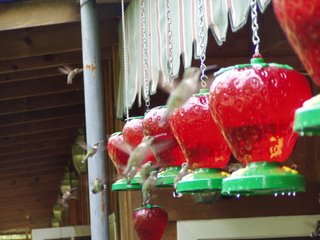
Dick Lancaster sent an email saying he had even more birds this week, if I wanted to come see and video them. Well, even though I'd spent all morning at Tickfaw, how could I resist. I mean, a cold front can come through at any time and they'll all be gone...
He was right -- even more birds! It was something to see. He said he had 50 feeders up and was going through about 50 pounds of sugar a week. That's a lot of work!
This video gives you an idea of what his patio looks like with all the feeders lined up like a row of strawberry plants

And this one concentrates on a single feeder. This feeder for some reason was especially popular. Where most feeders had 3 or 4 birds trying to use it, this one had 'em lined up on the heli-pad.
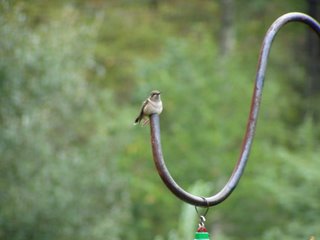
I love the shot of this little guy -- his little belly is fairly hanging over the edge of the post!
Sunday, September 17, 2006
Tickfaw on Sunday
Got a t-shirt that says "Life is Simple. Eat. Sleep. Bird"
Saw a funny sight as I was leaving the park. Two horse drawn wagons with a couple (man and woman) in each...but instead of a hard plank bench to sit upon, the wagons had each been outfitted with plush bucket seats. Very anachronistic.
Monday, September 11, 2006
Hummingbird and Butterfly festival - Folsom, LA
They also did a butterfly release, which I suppose would have been more spectacular on a sunny day when the butterflies would have been more inclined to fly. It was still fun, but they did have to help the insects out a little.
Butterfly release
Personally, I think the slight overcast helped make the colors pop...
What do you think?
and, because one can never get enough of the Mighty Calliope... Here he is again
Migration madness!
Back in July, the nature society in West Feliciana hosted a hummingbird festival and invited folks out to watch the banding and enjoy the birds in general. The last house on the tour was not a banding site, it was simply a viewing location. Mr. Lancaster had about 24 feeders up on his patio...and more birds than I've ever seen! But the amazing thing was, he was starting a call list for folks that were interested in coming back later in the season "when he really had some birds!" Last week, I got the call, so I went up there on Sunday.
oh. my. goodness.
There were so many birds that the wing hum was a roar! And the chittering and twittering was a cacophony! I tried to capture it on video, but I don't think I did it justice...I may have to ask him if I can go back again!
Here's a sample. Be sure to have the sound turned up!
Bird banding at Whiskey Bay
What exactly *is* a mist net?
Unhappy Vireo in mist net
Banding the Vireo
Sunday, August 06, 2006
Birding Whiskey Bay
It was raining when I left Baton Rouge and rainy when I got to Whiskey Bay. Thought I was foiled, but thankfully it cleared and it was actually cool all morning -- the thermometer on my car didn't get above 80 til after noon.
The buntings were plentiful, but either I didn't see any mature male painted buntings or they've already lost their breeding plumage, because I didn't see any that made me go "wow!" Saw a Yellow Warbler near the tower just past the watering hole...didn't look it up at the time, just made field notes. Headed on down to Happy Town road and saw a young turkey in the road -- later I would see a group of 5 more. Nothing much happening at the bridge -- couple of fisherpeople there who were not having any luck either.
The Miss. Kites were numerous. Largest single group I saw was 5 in one tree. No swallow-tail kites this trip. Cardinals and tanagers were numerous and vocal. Had one Roseate Spoonbill flyover while it was still early. All the other wading birds were found at the campground end, as were the Bluebirds. I did see several hummingbirds throughout the trip, and interestingly enough, saw a couple of pairs that had to be mother/child. Even observed one fledgling begging, altho mom wasn't cooperating. Juveniles of several species were present, and usually very vocal! Other wildlife included a family of rabbits, two live armadillos (which I believe is a personal record) and one spectacular large gray snake (at least 6 feet but not too thick at the middle). The Golden Silk Spider webs were most impressive decorated with the rain drops.
Just before I left, I decided I'd go back and try to video the Yellow Warbler because I thought it might be an early migrant, so I turned around and headed back to the spot, and pulled off the road...right into a well-disguised mud hole. I drive an SUV, but it’s one of those “citified” versions which doesn’t have 4-wheel drive. As it was, the front tires were completely coated with slick gray clay and I was very stuck. Now for those of you who've birded at Whiskey Bay you know that there is usually a never-ending parade of guys with trucks, usually pulling a boat and hauling a** down that road. Well, evidently they all stayed home today. I waited for over an hour for *anyone* to pass by. And then it was some guys in a minivan! But shortly thereafter came the guy in the Big Truck, with the Tool Box, who rigged up a rope and hauled me right out. So, thanks to my Good Samaritans. Lesson learned: stay on the road or the obvious gravel driveways.
Number of species: 52
Wednesday, August 02, 2006
Green Herons are abundant around the LSU lakes this time of year. In May you could find breeding birds in every stage...setting up nests, sitting on eggs, feeding fledglings, and then, like this group, learning to forage on their own. I love this group of "teenagers" with their punk hair, bickering in the cypress trees..
Sunday, July 30, 2006
Broad-tailed hummers
These Broad-tailed hummers are western birds, and while a few are found each year in the South, they are very rare. Plus when they are found, the wing feather that causes this wonderful whistle is worn down, so we don't get the show!
Listen to the wing whistle!
See the pretty ladies
You know that's not a Ruby-throat..it's magenta!
Hummingbird festival

I am so behind! Not sure how I'll ever catch up.
This weekend was the Feliciana Hummingbird festival. Banding by Nancy Newfield and Linda Beall at two locations and then hummer watching at the third! More hummers than I've *ever* seen in my life!
This wonderful picture was taken by my birding friend, Sybil. What a great shot!
Wednesday, May 24, 2006
Young'uns!



We are seeing young’uns everywhere! In the backyard, the Downy Woodpeckers, the Cardinals, Mockers, Brown Thrashers, Crows, and the Chickadees are all bringing their babies to the yard and showing them the ropes. But today I got a special treat! I work in a 12 story building in downtown
After work I went by City Park/Univ lakes to try out my new scope. Not much to see at a distance, but I did get a very close look at a trio of Juvenile Green Herons. They were along the lake bank, almost in the duck and pigeon congregation. When they saw me looking, they beat it for the safety of a cypress tree. No parents in sight. I’ll go back tomorrow to try to get pictures. They were not quite adult size and still in juvie plumage – but obviously could fly a bit to get off the ground to get into the tree. I sought out one of the Green Heron nests to see how things were coming there. This one is in the “cove” near the gazebo with the scalloped bridge. The nest is under a cypress and not easy to see from shore, but I could make out 3 fuzzy, wobbly heads in the nest there too! Tomorrow I’ll check the other nest near
What fun!
Sunday, May 14, 2006
Green Heron Nest!
Sunday, May 07, 2006
Hummingbird nest!!
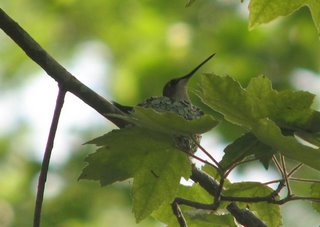 I happened to be in the right place at the right time when someone spied a Ruby-Throat Hummingbird nest. It's at a local park and the nest is right above the boardwalk. Here's hoping she keeps the nest a secret. She was amazingly still while we watched her, so I'm sure she'll do fine.
I happened to be in the right place at the right time when someone spied a Ruby-Throat Hummingbird nest. It's at a local park and the nest is right above the boardwalk. Here's hoping she keeps the nest a secret. She was amazingly still while we watched her, so I'm sure she'll do fine.And now for the videos - live and in living color
And once in silohuette
I went back this weekend and the nest is still there. Momma didn't come to it while we watched, and another observer said he had to wait over an hour to see her come to the nest -- but he did see her feed at least one nestling! woo-hoo! Maybe it'll be a little more visible once the baby 's a little bigger...it couldn't possibly hide in that teeny-tiny nest very long!
Saturday, May 06, 2006
An Endangered Species here in Louisiana
The forest where the birds live in Louisiana is primarily loblolly pine, although they are replanting the longleaf pine for the birds -- they just grow extremely slowly. They've helped the colonies along in some places by placing nesting boxes in the trees, which the birds seem to acccept. The nesting trees are marked with white rings around the trees, which is great for us lowly visitors. The forests are managed with fire. That is, they do controlled burn of the forest to thin and remove underbrush periodically and they also keep the trees at a certain density to keep it all healthy.
This first video is of a tree that shows a man-made nesting box that was inserted into a tree. You can see it's been well used...the sap wells around the hole are well-developed.
These next videos show the birds in and around the nesting hole. It was fairly early in the morning and the light wasn't great, not to mention the hole was about 20 feet above the ground, but I did the best I could. I hope to go back and try again one day.
Red-cockaded WP - best shot
Red-cockaded WP at the hole
Red-cockaded WP working the tree
Yellow Breasted Chat -- what a bird!
I ran into a new bird on my first visit to Whiskey Bay. There were plenty of these guys and they are anything but shy! I get such a kick out of watching them. They have terrible posture, and they look like they're retching when they sing. The field guides describes their flight as "awkward" -- that's putting it mildly! How on earth do these birds migrate across the gulf!
Here are some shots of the Yellow-Breasted Chat.
Chat on a wire -- talk about bad posture!
Chat in a tree
A little bit closer
and a close up of the Chat singing his song
Sunday, April 02, 2006
Audubon Country Birdfest
Saturday they had two busses running to the three locations. The early bus took the first group of about 15 to Murrell Butler's country home. What an outstanding property! It had a sprawling ranch feel, but had a little bit of everything -- forest, pond, swampy lake, fields, orchards, live oaks, and ornamentals around the wonderful natural wood sided home.
We immediately saw a pair of nesting Canada Geese. The hen was lying prostrate across the nest when was a man-made island in the pond. It was a little amusing. I guess she was trying to be innocuous, or maybe she was trying to rest up before the babies are born -- smart goose. There was also a pair of Eastern Kingbirds at the pond, a Northern Rough-winged Swallow, Green Heron, and a pair of green birds?? Yes, indeed, there's a pair of Monk Parakeets over there! It would have been a little freaky if Mr. Butler hadn't been there to tell us that he raises them...he has a large cage near the house but lets them out to fly. He said at one time he had a colony of 14, but the predators got them.
We saw the first of many Orchard Orioles, including a second-year male in his yellow plumage (so pretty!). Eastern Bluebirds were everywhere. Our coolest flyover of the day was a male Bald Eagle off in the distance. Down by the lake we saw several different shore/wading birds including Common/Wilson's Snips. We also saw our first Prothonotary warbler -- exciting moment! There were Ruby-Throat Hummers by the house, and no wonder with the coral honeysuckle, red buckeye, and various and sundry other hummer-friendly plants in bloom.
At Ouida, we finally saw the elusive Northern Parulas, which are vocal and hide very well. Also saw my first Broad-wing Hawk. We heard a Hooded Warbler and looked for him for a good long while but just couldn't find him. The Am Goldfinches were still there at the thistle feeders -- especially fun because they've molted back to summer plumage and are so pretty and bright!
It was late by the time we got to Rosale and we didn't pick up anything new. The day count was over 50 by the point, so not too shabby! I stopped by the Port Hudson Cemetery on the way back to BR...I'd never been and could see on the map that there was water nearby. Turns out there's a good lake system right there, but it's all on private property across the fence from the cemetery. I did manage to pick up 8 more birds just from the road though, so that wasn't bad.
On Sunday,we carpooled to Wyoming plantation. It's over a thousand acres! A caretaker drove us down the road a piece. We got out and walked back toward the front, detouring by a lake at one point. Finally saw that elusive Hooded Warbler! Prothonotary Warblers were very visible and everyone had a good shot at a pair that were showing off for us. Had a couple of Mississippi Kite flyovers - first of season for them. A Scarlet Tanager was another Pick of the Day -- could easily have been missed since the tendency is to dismiss all "red-birds" as cardinals, but someone was paying attention to this one and we got it.
Fun, birdy weekend! Didn't get a lot of videos because most of the birds were very distant -- if I filmed them you'd see little moving specks and you'd just have to take my word for it :-) Not all of the great wildlife was feathered -- the butterflies were out in force, and some of them rivaled the birds...
This Green Heron deserves his own post...
Saturday, April 01, 2006
The Redneck Vireo
Great little video of the Redneck Vireo
Sunday, March 26, 2006
Lucky Ducks!
On the other side of the lake was a Momma Mallard. She had a very large brood...twelve ducklings. She was leading the group from a feeding spot to the lake, when one of the little boogers got turned around and headed the wrong way...straight for the road! I wasn't going to interfere but he seemed to determined to get into harm's way. Momma was busy with the other eleven and couldn't go after him...so I stepped in. He didn't like his first flight...but he was relieved to get back to Mom. What a bunch of cuties!!
Saturday, March 25, 2006
I do have a Ruby Throat!
Click to see Mr. Flashy
Thursday, March 23, 2006
Hummer census
Sunday, March 12, 2006
Second trip to Lake Martin
The Spoonbills had gotten a little farther along in their mating process. They seemed to be pairing off and building nests. I bet they'd give anything for opposable thumbs!
Everything has to be just so...
I TOLD you not to touch that!!
The Egrets were definitely paired off and had well-established nests. We saw some Egret-nookie going on, and I shan't be surprised to see little Egret babies before too long...
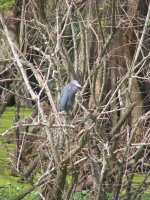
Love, Egret Style
The Little Blue Herons were on alert looking for the odd frog or fish...
Got one!
And the ungainly Common Moorhen looked on with envy in his eyes...
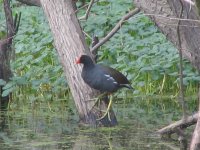
Get a load of those feet!
Mama Gator and her pups were enjoying the sunny day...hoping a bird would stop by for a snack...
Here, birdy-birdy-birdy!
Saturday, March 11, 2006
Trip to Tickfaw
I picked up about a dozen different types of Salvia at Naylor's yesterday and got them planted today. Should be quite a smorgasbord at the end of the driveway for my summer hummers! People all over the South are spotting Ruby-Throated Hummingbirds already, but I haven't seen one yet. I saw a female Rufous yesterday and today at two different feeders. Not sure how many birds though...
Tomorrow Lake Martin again!
Sunday, March 05, 2006
Weekend birdwalks
On Sunday morning I spent some time at Summit Lake. Saw my first-of-the-year Towhees. Sparrows are still hanging out (White-Throated and Swamp). Also saw at least two House Wrens. Not an outstanding day, but not bad either...
Tuesday, February 28, 2006
Mardi Gras outing...
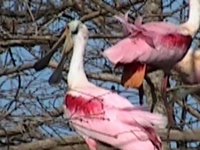 We had bee-yoo-tee-full weather in Louisiana this year for the Mardi Gras. I decided to forego the revelry and head for the woods instead. Decided to try a new location today and headed with a BR Audubon society friend to Lake Martin near Breaux Bridge. It was an easy hour drive and we were rewarded immediately on arrival to the rookery with a great view of Roseate Spoonbills and Great Egrets in the cypress trees. The Spoonbills are the greatest color this time of year...orange and strawberry sherbet! They haven't quite paired off yet and started nesting, but there sure is a lot of clacking going on! I can't tell if they're mating or fighting! We got some great views of Red-Shoulder Hawks as well. Gorgeous colors!
We had bee-yoo-tee-full weather in Louisiana this year for the Mardi Gras. I decided to forego the revelry and head for the woods instead. Decided to try a new location today and headed with a BR Audubon society friend to Lake Martin near Breaux Bridge. It was an easy hour drive and we were rewarded immediately on arrival to the rookery with a great view of Roseate Spoonbills and Great Egrets in the cypress trees. The Spoonbills are the greatest color this time of year...orange and strawberry sherbet! They haven't quite paired off yet and started nesting, but there sure is a lot of clacking going on! I can't tell if they're mating or fighting! We got some great views of Red-Shoulder Hawks as well. Gorgeous colors!The Great Egrets were in full-on breeding mode. Some were doing the Egret Mating Dance. It was very cool...they would show off the long breeding plumage tail feathers and do their repetitive, ritualistic dance. Some had paired off and started nests. I couldn't tell if there were eggs yet.



We saw a few shy Moorhens working along the water's edge. Along with many Alligators that were just hanging around looking for, shall we say, lunch opportunities.

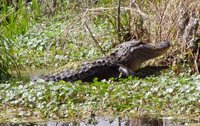
We saw a few Swamp Sparrows and some other un-identified "little brown jobs" . One of the coolest things for me was the flock of Ruby-Crowned Kinglets. Usually I would just see one, but there must have been a dozen or more all in one place chittering away. And they brought a Northern Parula with them! Another first :-)
A Black-Crowned Night heron was there see us off as we headed back to town it had the neatest tail presumably its version of breeding plumage

It was a great outing and I plan to go back a few times this spring to see the Spoonbills and Egrets nesting and fledging... I tell you, I felt completely inadequate with my little camera and vid-cam though--you should have seen some of the rigs these folks had! Next time I'll take a picture of them :-)
Monday, February 27, 2006
My little yellow spot
Sunday, February 26, 2006
Beautiful day for a field trip!
I saw a Red-Headed Woodpecker first thing out of the box! First one I've seen all winter. A couple of Mockers and Shrikes were hunting and tussling from the fence. We were here to find sparrows though, so we set out to find them. We walked, listened, and did not see a thing except hawks and vultures in the distance. I heard something calling, but could not find it. Finally I flushed a "LBJ" and we tried to close in on it, but it eluded us. Bob and I both got the impression of "wren" but we couldn't be sure, and it made no sound.
A bit later we did see a couple of sparrows that hid in the shrubbery and we id'd them as swamp sparrows. Since there wasn't much to see in this location, we decided to head to St. Gabriel to go Snipe hunting.
On hwy 30 (Nicholson) just as you cross the parish line from the north, there is a hardware store on left near a sheriff's substation. Behind these buildings are two areas...one grassy, marshy open area and a fenced area of shrubby growth. We immediately saw a pair of Mockers and Shrikes--this was the day for them. We started out in the grassy field and immediately spotted several Killdeer and then suddenly SNIPE! They popped up as they were startled out of the grass and surprised us, too. Their camouflage was amazing...at one point I came within 15 feet of one that I did not even see until it flew. I know I didn't get any good pictures but got great looks! We also saw a group of about 8 or 9 Eastern Meadowlarks in the same area. They were almost as leery and hard to photograph.
We made our way back to the edge of the shrubby area and found a small flock of White-Crowned Sparrows working the edge of the fence. I managed to get within 10-12 ft or so so the pictures should be fairly decent.
We detoured out Ben Hur road to see what we could see. Found significant flocks of Chipping Sparrows, Savannah Sparrows, and blackbirds (Cowbirds, Starlings, RWBB) and the occasional wader (Cattle, Great, Snowy Egrets). Lots and lots of hawks (90% chance of Red-Tailed :-) ), several vultures and a few Kestrels. No Pipits this time, which was unusual considering their abundance just last weekend.
All in all, a good birding day and I added 5 birds to my List :-)
Sunday, February 19, 2006
Great Backyard Bird Count 2006
I contributed the list from yesterday as well as what I've seen in the yard yesterday and today. I'll also let them know about this wonderful Selasphorus Rufus that I was lucky enough to photograph in neighbor Carol Thomas's yard today. Isn't he a beauty? But then I'm partial to redheads :-)
Click here to see the Rusty Rufous
Saturday, February 18, 2006
BR Audubon society field trip...
Had forgotten to account for wind down on the river -- it was cold and much breezier down there, not to mention muddy. I was wishing I had my gloves and another layer of jacket! We made a wide circle at Richfield Riversilt...veering off the left off the main road at first to pick up water birds in the pits. It's positively amazing how well camoflaged those shorebirds are! Sparrows were abundant -- we picked up eight different species over the course of the morning. Here are links to videos of two of the sparrows we saw today -- both of which were lifers for me:
Le Conte's Sparrow:(19Mb file)
Le Conte's Sparrow (9Mb file, excerpt from above)
Le Conte's Sparrow (18Mb file - different angles)
Vesper Sparrow: (8Mb file)
We picked up 50 species altogether. Here's a complete list:
Double-crested Cormorant - 3
Great Blue Heron - 1
Great Egret - 3
White Ibis - 30 (Observed on Lee Drive on drive back to Coffee Call)
Northern Harrier - 1 (possibly 2)
Sharp-shinned Hawk - 1 (or Cooper's)
Red-tailed Hawk - 10
American Kestrel - 1
Killdeer - 25
Spotted Sandpiper - 1
Western Sandpiper - 2 (debate about Western or Semipalmated, but I think the consensus was Western)
Least Sandpiper - 4
Common Snipe - 1 (St. Gabriel)
Ring-billed Gull - 5 (flyover, so hard to tell, but probably)
Rock Pigeon - 12
Mourning Dove - 6
Red-bellied Woodpecker - 4
Yellow-bellied Sapsucker - 1
Downy Woodpecker - 1
Eastern Phoebe - 2
Loggerhead Shrike - 1
Blue Jay - 1 A
merican Crow - 8
Carolina Chickadee - 2
Carolina Wren - 2
Ruby-crowned Kinglet - 3
Blue-gray Gnatcatcher - 1
Eastern Bluebird - 3
American Robin - 1
Northern Mockingbird - 4
Brown Thrasher - 1
European Starling - mixed flock with RWBB
American Pipit - 50
Orange-crowned Warbler - 2
Eastern Towhee - 1 (heard not seen)
Chipping Sparrow - 50+
Field Sparrow - ~10
Vesper Sparrow - 3
Savannah Sparrow - ~90
Le Conte's Sparrow - 3
Song Sparrow - 4
Swamp Sparrow - 1
White-throated Sparrow - 10
White-crowned Sparrow - 1 (St. Gabriel)
Northern Cardinal - 12
Red-winged Blackbird - 100's maybe 1000's
Eastern Meadowlark - ? (heard not seen)
Common Grackle - 4 (but may have been more in mixed flocks)
Brown-headed Cowbird - 100's (separate and mixed flocks)
Saturday, February 04, 2006
First Saturday in February
BR Audubon Society sponsors a birdwalk the first Sat of every month at Bluebonnet Swamp, a park here in Baton Rouge. We didn't have a BRAS guide this month, so we made do. Fortunately we had some experienced birders to help us spot and identify the interesting birds. The highlight for me was the Barred Owl that we got very good looks at, and the Blue-Gray Gnatcatcher, which isn't that rare but is always a treat. It was a cool, breezy but clear day and fun to meet new "birdy" people...
The complete list is as follows:
Wood Duck
Great Egret
Black Vulture
Mourning Dove
Barred Owl
Red-bellied Woodpecker
Yellow-bellied Sapsucker
Downy Woodpecker
Northern Flicker
Eastern Phoebe
Blue Jay
Carolina Chickadee
Tufted Titmouse
Carolina Wren
Golden-crowned Kinglet
Ruby-crowned Kinglet
Blue-gray Gnatcatcher
American Robin
Northern Mockingbird
Brown Thrasher
European Starling
Cedar Waxwing
Warbler sp. - we got a brief glimpse of a very yellow bird with greenish wings. *Might* have been the Wilson's Warbler that was counted here on CBC day.
Northern Cardinal
Red-winged Blackbird
Common Grackle
Brown-headed Cowbird
Monday, January 23, 2006
The Mighty Calliope
*very* cooperative (for which his host takes complete credit :-) ). I got several minutes of him posing but here are the highlights:
Ready for my close-up
The action shots
I did get another shot of the Junior Calliope as well, but I'm not pleased with it. You can't really see the distinguishing characteristics of the bird, other than short bill and long wings--I need a different angle. Also got a great look at the Male Rufous that stays at the same house, but he did not cooperate for the camera. Another time for that one, too.
Also went over to LSU campus lake searching for the Yellow Warbler they've been warbling about on the LABIRD list. Found another birder on the same quest and together we found the bird. She was very hard to capture in the camouflage of the willows and from the distance (over 50 feet certainly from shore to the little swampy area she had staked out). But when an Orange-Crowned Warbler had the audacity to invade her space, she became very riled and I did get a few decent shots. The large version (26Mb) and the small version (5Mb)
Saturday, January 21, 2006
Another new bird!
I am participating in Cornell's Backyard Feeder Watch this year. It's been interesting because while I see a lot of the same birds every week, I think I've seen at least one new bird each week as well. This week was a small flock of cow-birds. Not too glamorous to be sure, but it adds to the list!
Monday, January 16, 2006
hummer plants
I want to add more plants... I am seriously considering expanding further into the back yard. Ned doesn't really *like* cutting all that grass, right? So he'll appreciate it if I add some trees, shrubs, planting beds....right?? hmmm, I'll have to do some planning.
I've got the planting bug...didn't help that it was warm and spring-like today...
Had an exciting moment this afternoon! I was standing in the driveway when all of a sudden a Sharp-shinned hawk flew about 10 feet from me, landed on the neighbor's arbor, perused the bushes for sparrows, dropped down in the azalea trying to catch one!! but missed and finally flew off to a nearby tree. I wouldn't have minded if he took a house sparrow with him :-)
Still have 3 hummers -- Yellow-Spot Rufous, Red-spot Rufous, and one unmarked Unknown.
Sunday, January 15, 2006
Another hummer day...
The next house hosted a slew of Black-Chinned birds. There was a live oak with several blooming hummer plants, dominated by the large Turk's cap. EAch bird seemed to have staked out its tiny territory, but every once in a while the boundaries would be violated and then the battle was on! There was a male Rufuous at this house as well, but he'd staked out a claim to the back yard. We also saw two Baltimore Orioles, a Blue-Headed Vireo, Red-crowned Kinglet, and a Blue-gray gnatcatcher.
The last house on the tour had a small yard and the owner told us he was hosting only three birds, but much to his surprise, a 4th showed up while we were there. The new one was a Black-Chinned female. He also had an adult male Rufous (wonderful coloring!). But the stars of the show were the Calliope hummers. The young male was fairly nondescript, but he was still neat to see because of his shape--small bird, short bill (compared to other hummers) and wings longer than his body which gave him a big-headed, pot-bellied look. The adult male, however, has this wonderful metallic purple gorget that is unlike any other hummer and certainly makes him stand out! What a treat to see!
As for my own hummers... my back-yard Rufous(yellow spot) is still around. I have seen another bird or birds, but have not yet ID'd it/them. I haven't seen the Red-spot Rufous, so it may have moved on after the trauma of banding.
Wednesday, January 11, 2006
And the Black-Chinned females...
This is the larger of the two and the BC that I saw first:
Sleek beauty
This little pretty I saw a few days later. I saw her at first from across the yard and thought the pink spot on her head was feathers...I'm looking all through my book for a pink-headed hummer! Turns out she was already marked. I posted a message on Humnet and she might have been marked and banded as far away as Alabama! How cool would that be! Unfortunately neither one of the Black-Chinned hummers cooperated with us on banding day. Maybe there will be a chance to try again.
Hummer with a pink spot
Here are the hummers
Back yard Rufous
The front yard Rufous is a younger bird. Nancy marked it with a Red spot. Unfortunately I haven't seen it since last Sunday when it was banded, and I sincerely hope we didn't frighten it away permanently.
Li'l Rufous cusses me out in the morning
later in the day, when all is quiet and good with the world, she rests
Sunday, January 08, 2006
Hummer banding at home
I have some pictures to share, and will be posting video as well. What a fun experience!
Saturday, January 07, 2006
Four winter hummers!
All the birds have been ID'd by video and in person by our local experts... and tomorrow they are coming to band them, if they can catch them. You can be sure I'll have pictures!
In the meantime here are some pictures of my hummers...
Li'l Rufous cussin' at me in the morning
And then later in the day, sun gently shining, no others hummers or humans around, the Li'l Rufous sips








